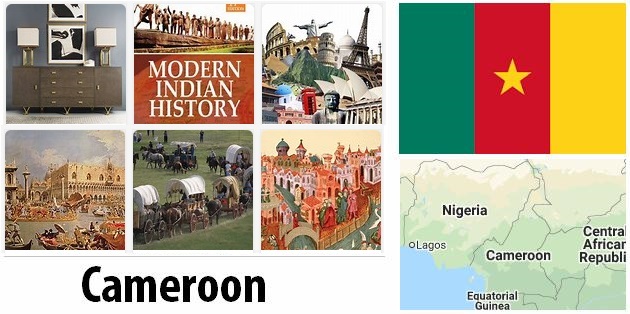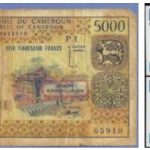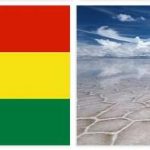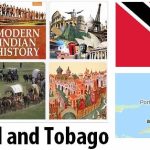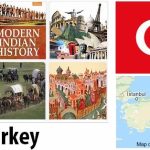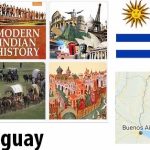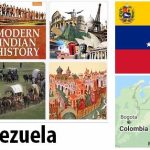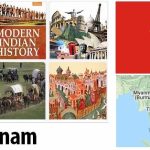Cameroon is a country located in Central Africa. With the capital city of Yaounde, Cameroon has a population of 26,545,874 based on a recent census from COUNTRYAAH. After some turbulent years, the Federal Republic of Cameroon was formed in 1961 through a merger between the southern part of British Cameroon and the Republic of Cameroon. The country’s first president was Ahmadou Ahidjo. In 1982, Paul Biya took over as president. He has managed to retain power since then despite political unrest, mutual conflicts and suspicions of electoral fraud.
On October 1, 1961, the Federal Republic of Cameroon was created when part of the British colony of Cameroon joined the Republic of Cameroon which gained its independence the year before (see Older History). The federation consisted of two units: the old French Cameroon became Eastern Cameroon and the former British part became Western Cameroon. Both French and English became official languages.
- ABBREVIATIONFINDER: List of most commonly used acronyms containing Cameroon. Also includes historical, economical and political aspects of the country.
President Ahmadou Ahidjo began the work of uniting the two regions. In 1966, a single party was formed, the Cameroonian National Union (UNC). In 1972, nearly 100 percent of voters voted in favor of a new constitution that gave the president great powers and replaced federal state formation with a strongly centralized administration. UNC became the only allowed party.
In foreign policy, President Ahidjo ran an alliance-free line and sought to reduce dependence on France and other Western countries. In domestic politics, Ahidjo and UNC had full political control. The regime was favored by strong economic growth during the 1960s and 1970s. It was initially based on the export of coffee and cocoa as well as increased self-cultivation and accelerated when oil from the late 1970s became an important export product. Oil revenues were used, among other things, for a strong expansion of the public sector. Check best-medical-schools for more information about Cameroon.
Paul Biya takes over power
The tough political control created discontent under the surface. Underground opposition groups began to protest against Ahidjo’s authoritarian rule in the late 1970s. In the English-speaking part of the country, the irritation over the French-speaking dominance of the government increased.
In 1982, Ahidjo volunteered to hand over the presidential post to the then Prime Minister Paul Biya. Ahidjo regretted afterwards but was forced into exile, where he died in 1989. Under Biya’s rule, the country was characterized by ever stronger internal unrest. While Ahidjo had tried to gather representatives of all regions and peoples of the UNC government, Biya built his power base on a network of the French-speakers in central and southern Cameroon. People’s groups in the north and the English-speaking residents felt neglected.
President Biya was re-elected in 1984 and 1988, but he lacked counter-candidates and there was electoral fraud. After the first election, loyal army forces defeated a coup attempt by supporters of Ahidjo. The failed coup became the beginning of a period of systematic repression of all political opposition. Biya tried to give UNC a facelift by renaming the party to the Cameroonian People’s Democratic Assembly (RDPC) in 1985.
In the second half of the 1980s, Cameroon was plagued by a growing economic crisis caused by falling world market prices of oil, coffee and cocoa. Initially, the government used saved oil money to hide the loss of income, but after a few years the reserves were depleted. Gradually, Cameroon was forced to take out large loans abroad and the foreign debt rushed. In cooperation with the IMF, a four-year austerity program was initiated in 1989 that included privatization of state-owned enterprises and redundancies of public employees.
Demands on democracy
The economic tightening coincided with ever stronger demands for democracy. A series of protest campaigns began in 1990. Faced with the threat of civil war, the government felt compelled to introduce multi-party systems. But the opposition also called for a national conference to set an election date. When the government refused, the unrest escalated and over 100 people were killed in clashes between protesters and police. In the spring of 1991, eleven leading opposition parties formed an alliance and pressure against the government increased.
Cameroon’s first multi-party was held in March 1992. It was boycotted by 16 opposition parties, including the Social Democratic Front (SDF), which represented the English speakers and who were on the strong rise under the leadership of the charismatic John Fru Ndi from western Cameroon. On the other hand, another important opposition party, the National Union for Democracy and Progress (UNDP), participated, which had strong support among Muslims in the north. President Biya’s power party RDPC received almost half of the mandate, while UNDP won just over a third. The RDPC formed a government with one of the smaller parties in Parliament.
In the subsequent presidential election in the autumn of that year, Biya won 40 percent of the vote, against 36 percent for Mrs. Ndi. Both attributed the victory. Biya was accused of cheating by independent observers.
After several years of economic decline, a turning point came in 1994 when the country’s currency was devalued sharply, which accelerated exports and growth. In 1997, parts of Cameroon’s foreign debt were written off. The same year, the IMF approved a new economic adjustment program that would improve the country’s competitiveness through, among other things, trade liberalization.
The constitution is changed
Under pressure from the outside world, President Biya had, in the spring of 1993, initiated a process to review the constitution. In December 1995 Parliament adopted several constitutional amendments which came into force in January of the following year. The term of office of the President was extended from five to seven years, while the number of periods that a person was allowed to hold the office is limited to a maximum of two. The House would also be provided with an upper house, a Senate, with 100 members. A constitutional council would also be set up.
In the May 1997 parliamentary elections, the RDPC won by a large majority. The choice was characterized by widespread cheating. As a result, both the SDF and UNDP boycotted the presidential election in October of that year, won by Biya.
Biya tried to disarm the opposition parties by offering them seats in the government. UNDP agreed to a collaboration, while SDF declined. In December 1997, Biya formed a coalition government consisting of RDPC, UNDP and a few small parties.
A few years earlier, the English speakers’ dissatisfaction with the government and demands for self-government had led to the founding of the Separate Movement of the Southern Cameroon National Council (SCNC). In 1999, three members of the SCNC were sentenced to death for blast attacks carried out before the 1997 parliamentary elections. Another 35 people were sentenced to prison for up to 20 years. In the fall of 2001, the army sent hundreds of soldiers to stop two manifestations demanding autonomy in one of the English-speaking areas. Three people were shot dead by the police and around 140 were arrested, among them leaders of SCNC.
In 1999, Biya declared war on the widespread corruption in the country. In September, a minister was forced to resign because of allegations of misappropriation of public funds.
Split within the opposition
In October 2000, Cameroon qualified for the so-called HIPC initiative, which targets heavily indebted poor countries and is administered by the IMF and the World Bank. This meant large debt write-offs in the long run (see Financial overview).
Ahead of the June 2002 parliamentary and local elections, unrest in the English-speaking areas increased. The SDF claimed that its candidates had been banned from running in more than 100 constituencies. At least ten people were injured in political clashes, and the elections were postponed for a week. The official results showed, as expected, that the RDPC significantly increased its dominance and took home 149 of the Parliament’s 180 seats, while the SDF received 22 and the UNDP only 1 mandate. The opposition accused the government of electoral fraud and was upheld by the Supreme Court, which ordered the re-election of 17 seats.
The election loss gave rise to increased fragmentation within SDF. Four senior members, including the vice-chairman, resigned and accused the leader John Fru Ndi of leading the party with dictatorial methods.
At the same time, UNDP leader Bello Bouba Maigari was pressured by his supporters to stop cooperating with the government, which he did not. In the fall of 2002, a group of ministers from the UNDP’s strongest stronghold in the Northern Cameroon government accused the government of neglecting the region.
Biya broadens its power base
The ruling party also began to show signs of internal fragmentation. A group of lower-level party officials, who said they had indirect support in the leadership layer, went out and demanded that the party renew itself and become more open.
In the 2004 presidential election, Biya clearly won with 71 percent of the vote, while Mrs. Ndi came second with 17 percent. The turnout was only about 20 percent and there were allegations of electoral fraud. However, the opposition’s attempt to have the election annulled was rejected by the Supreme Court.
In 2004, Biya reformed the government in an attempt to broaden its power base. New Prime Minister became the English-speaking Ephraim Inoni and three ministerial posts were occupied by Muslims from the north.
Under pressure from international lenders, the government began the decentralization of power enshrined in the 1996 constitutional amendments (see Political system). In 2004 Parliament adopted the laws required to initiate decentralization, but nothing happened after that.
In 2005, the government initiated a series of measures to, as it was said, make the government of the country more democratic and effective. A new authority was created to increase control over the state’s finances, and a law was passed requiring all civil servants to account for their personal assets.
Violent riots
In 1999 and 2004 Cameroon was ranked as the most corrupt country in the world by Transparency International. In 2005, the government launched a campaign against corruption. Some 70 top officials were dismissed for embezzling public funds. Over 500 employees at the Ministry of Finance were spotted and a study found that the state paid monthly salaries to 45,000 employees who did not exist. The campaign was stepped up in 2006 when the president created a national anti-corruption commission directly under his command. More than 100 people have been arrested for corruption, including two MPs and a high party official.
In the June 2007 elections, the RDPC won 153 of the 180 seats in Parliament and also won big in the local elections. The turnout was very low. According to the opposition, massive electoral fraud occurred and the SDF vainly demanded that the elections be annulled.
Price increases on fuel and food triggered violent riots in February 2008, which spread from Douala to several other cities. Eventually, the protests went over President Biya’s plans to change the constitution so that he could be re-elected when his term expired in 2011. When the police failed to quell the unrest, military was also deployed against the protesters. According to official figures, 40 people were killed and over 1,500 were arrested during the violent protests. Biya accused political rivals of being behind the violence. Amnesty International said over 100 civilians were killed by security forces, many shot and others drowned as they jumped in a river in Daoula to escape police bullets.
In March 2008, the government promised a number of measures to reduce people’s dissatisfaction, including a wage increase for civil servants and military, reduced electricity fees and the abolition of tariffs on some imported basic commodities. Thereafter, a tense calm was reported again in the country.
“Constitutional coup”
The same month, three former ministers and other former government members were arrested as part of the anti-corruption campaign launched in 2005. The Minister of Finance, the Minister of Health and the Minister of Public Administration had all been dismissed from their posts in September 2007. They were charged with embezzlement of state funds. In August 2008, another corruption-suspected ex-minister was arrested.
In April 2008, Parliament passed a series of constitutional amendments that partly allowed Biya to be re-elected as many times as possible and partly protected him from prosecution even if he resigned as president. The ruling party argued that the changes were necessary to maintain stability in the country. SDF MPs boycotted the vote, which they termed a “constitutional coup”.
In June of that year, Parliament approved that the establishment of a new electoral authority be postponed for six months. The decision was criticized by both the opposition and civil society. When Biya presented members of the electoral authority in December, it turned out that most came from his own party RDPC. This raised doubts, including within the RDPC, about the independence of the electoral authority.
In January 2009, Amnesty International harshly criticized the Cameroonian government for serious human rights violations, including repression against political dissidents and difficult living conditions in the country’s prisons.
Yet another disputed presidential election
In June 2009, Biya furnished a lot about the government. He replaced Prime Minister Ephraim Inoni with another English speaker, Philémon Yang, who had previously worked closely with the President. Eight other ministers were also replaced.
The government’s anti-corruption campaign continued and in August 2009, seven government officials accused of embezzling public funds were arrested. Despite the campaign, corruption continued to be the biggest obstacle to investment in Cameroon, according to a report released by the World Bank in September that year. In January 2010, another former Minister of Corruption was arrested.
In October 2011, Biya won the presidential election with 78 percent of the vote against 11 percent for John Fru Ndi of the SDF. The SDF repeatedly complained about gross irregularities during the election process, among other things many names must have been missing in the voting lists, while others appeared twice.
